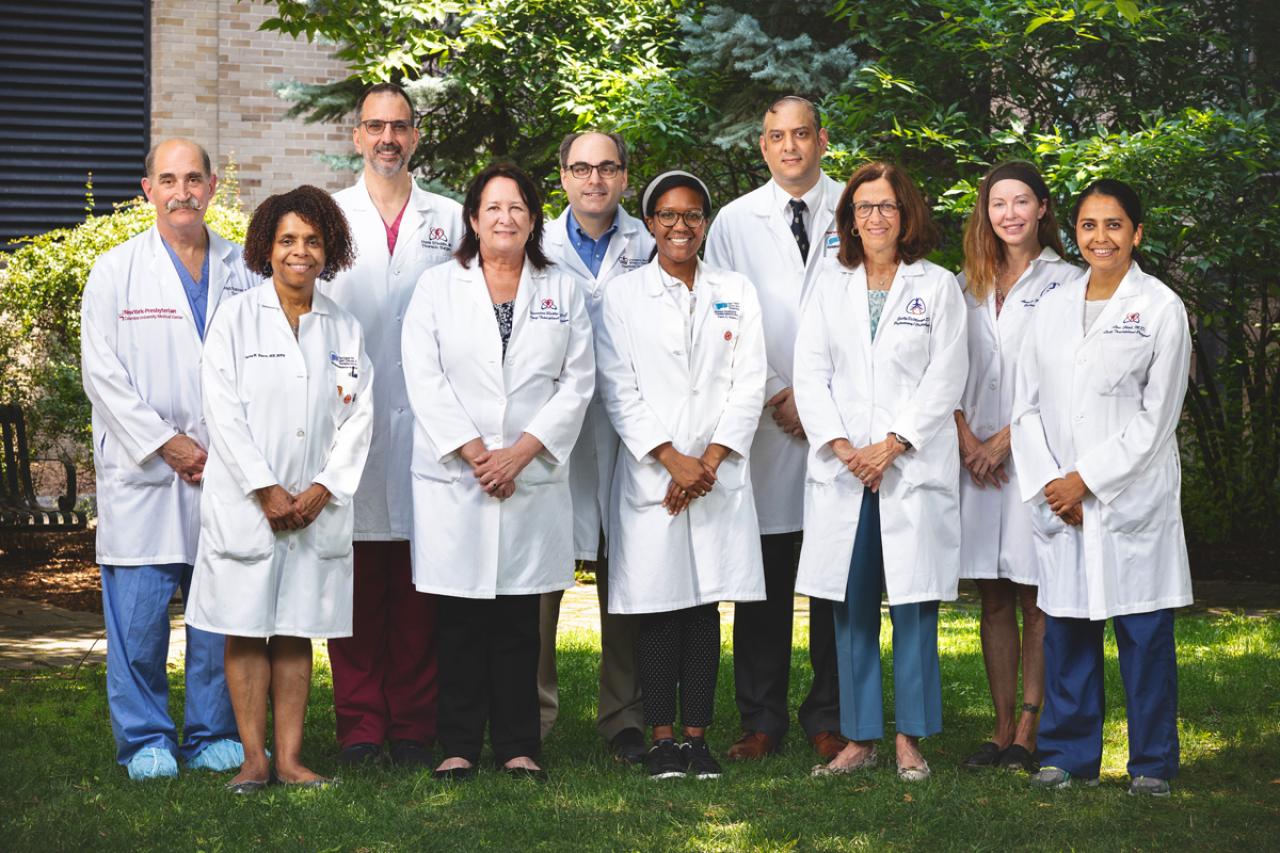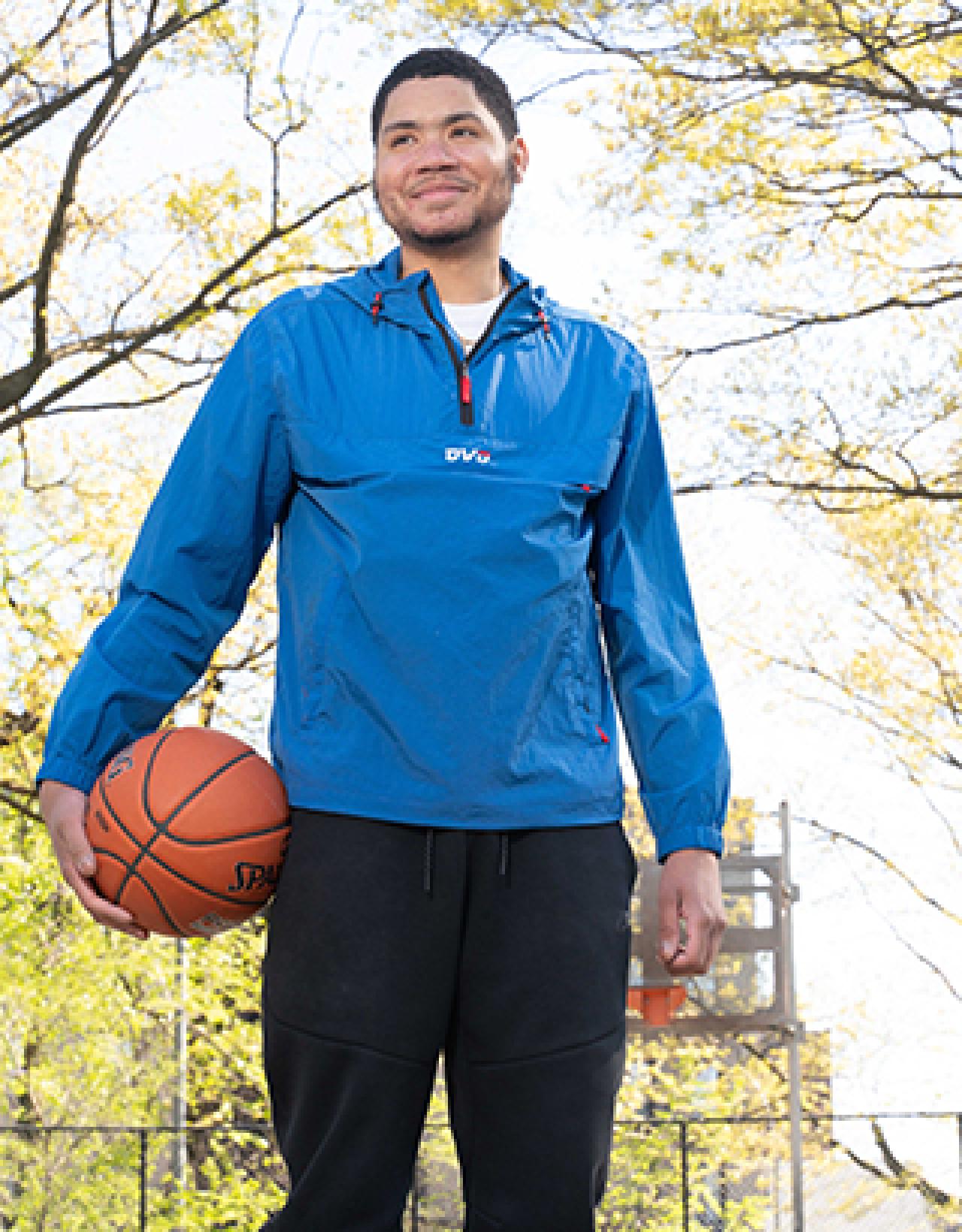There was a time when Raymond Fermin, a 24-year-old from the Bronx and an avid basketball player, had to witness life from the sidelines. Born with an aggressive form of cystic fibrosis-a genetic disorder that affects the lungs, pancreas, and other organs-Raymond started experiencing trouble breathing as a teenager. By age 23, cystic fibrosis had ravaged Raymond's body, causing multiorgan failure and leaving him with limited breathing capacity, recurrent lung infections, cirrhosis in his liver, and advanced kidney disease that led to dialysis.
"His quality of life was terrible," says Emily DiMango, MD, director of the Gunnar Esiason Adult Cystic Fibrosis and Lung Program at NewYork-Presbyterian/Columbia University Irving Medical Center and professor of medicine at Columbia University Vagelos College of Physicians and Surgeons. "He had frequent infections and needed frequent hospitalizations. It was getting increasingly difficult to keep him stable."
That all changed after Raymond underwent the first-ever triple transplant at NewYork-Presbyterian/Columbia University Irving Medical Center, receiving two lungs, a liver, and a kidney from one deceased donor. Raymond is the first lung-liver-kidney transplant patient in New York state and only the third such case reported in the United States, according to the Organ Procurement and Transplantation Network database. The 23-hour surgery started in the evening of July 16, 2020, and stretched into the next day, with a care team of more than 20 working around the clock to do their part.
"This transplant involved every team imaginable: our cystic fibrosis team, the lung team, the kidney team, the liver team, anesthesiology, the ECMO team, the cardiothoracic ICU team who would care for him after surgery. It really does take a village, and there is no way we would have been successful in Raymond's care from beginning to end without this multidisciplinary approach," says Lori Shah, MD, the transplant pulmonologist at NewYork-Presbyterian/Columbia University Irving Medical Center who was part of Raymond's care team and is assistant professor of medicine (in pediatrics) at Columbia University Vagelos College of Physicians and Surgeons.
Now, one year after his groundbreaking triple transplant, "I wake up every day feeling grateful that I'm still here and I can breathe now," Raymond says. "I've been given a second chance."
"I'd have to catch my breath"
Cystic fibrosis is a progressive disease that causes mucus to build up in your lungs, which leads to breathing problems. As a patient gets older, the condition can cause persistent lung infections that lead to scarring in the lungs and limit one's ability to breathe. It can also affect the digestive tract and the body's ability to absorb key nutrients from food. More than 30,000 people in the United States have cystic fibrosis, and the disease is the third-leading cause for lung transplants in the country.
When Raymond hit his late teens, he started to cough more and would get run down easily. Soon, Raymond-who also developed cystic fibrosis-related diabetes-found himself winded doing everyday activities, from making his bed to playing basketball. "I saw all my friends running up and down, and I'd have to catch my breath, or sometimes I'd sit out the game," he says.
"When he started telling me he really couldn't play basketball, that really struck me," says DiMango, who met Raymond in 2017 when he transitioned from the pediatric to the adult cystic fibrosis program at NewYork-Presbyterian/Columbia University Irving Medical Center. "That was not only exercise, but his social life."
In 2018, DiMango referred Raymond to Shah to start exploring a possible lung transplant-a welcome conversation that Raymond was eager to have.
Triple threat
Liver disease has become more prevalent in cystic fibrosis patients, presenting in an estimated 20% to 40% of CF cases in recent years. As a precaution, in 2019, Shah asked Raymond to undergo a routine liver exam as part of his lung transplant evaluation. That's when doctors discovered severe cirrhosis.
"We all have more liver than we need. Raymond had enough good liver to do everything the liver needs to do, but it would not have been enough to take him through the difficulty of a lung transplant," says Lorna Mills Dove, MD, director of clinical hepatology at NewYork-Presbyterian/Columbia University Irving Medical Center, medical director of adult liver transplants at the Center for Liver Disease and Transplantation at NewYork-Presbyterian, and professor of medicine (in surgery) at Columbia University Vagelos College of Physicians and Surgeons. Plus, "a liver that's scarred puts you at risk for increased infection post-transplant."
As doctors began to discuss a possible lung-liver transplant, Raymond had a kidney biopsy that revealed extensive chronic renal disease from IgA nephropathy, an inflammation in the kidneys that is not normally associated with CF patients.
"There are patients who've received combined lung-liver transplants, but having underlying advanced kidney disease makes it more likely that the patient will have major complications," explains Geoffrey Dube, MD, a transplant nephrologist at NewYork-Presbyterian/Columbia University Irving Medical Center and assistant professor of medicine at Columbia University Vagelos College of Physicians and Surgeons. "Doing two organs at the same time would only fix two-thirds of the problem."
By the fall of 2019, the three transplant teams reached the same conclusion: Raymond needed a simultaneous lung-liver-kidney transplant to give him the best chance for a successful recovery.
A triple transplant had never been performed at NewYork-Presbyterian. "We basically had to invent a surgical protocol for Raymond," says Shah.
It took significant effort to work out the details around the novel procedure with multiple meetings to discuss everything-from the procurement of the donor organs to the order in which the transplants would take place and how postop rounds would work.

A race against time
Then last March-just as the team was about to clear Raymond for the transplant waiting list-COVID-19 descended on New York City.
"There were just too many unknown variables to do a transplant safely, and that delayed when we felt comfortable activating him on the transplant list," Dove says.
While the transplant was on pause, Raymond's health continued to deteriorate during the pandemic.
"I was coughing up a lot of mucus. I was barely able to breathe, and I was using oxygen. Even sleep was hard; every hour I would wake up coughing," says Raymond, who was also undergoing dialysis three times a week for up to four hours per session.
In June 2020, Raymond got "the best news": His care team felt confident that the time was right, and they could safely add him to the transplant waiting list.
A few weeks later, on the evening of July 15, Raymond experienced severe bouts of coughing and was struggling to breathe more than usual. His mom insisted he head to the hospital, where he then started to cough up blood, a serious condition sometimes seen in patients with advanced CF lung disease.
He was immediately admitted to the ICU overnight, because of life-threatening bleeding from his lungs, which were only functioning at 20% capacity.
The next morning, "we get a phone call from the hospital saying Raymond is in really bad shape, and our hearts dropped," recalls his younger sister, Adrianna.
Serendipitously, on that same morning, a text chain among Raymond's care team lit up with an urgent message: There was a possible match for Raymond.
"When I woke up in the ICU, my mom and my sister were already in the room," says Raymond. "I remember someone came in and told us about the possible donor, and we all started crying."
Raymond didn't hesitate to sign the papers. Within three hours, word came back that the transplant was a go.
The triple transplant began at 6:32 p.m. with the removal of Raymond's damaged lungs by Frank D'Ovidio, MD, surgical director of the lung transplant program at NewYork-Presbyterian/Columbia and associate professor of surgery at Columbia University Vagelos College of Physicians and Surgeons.
"His lungs were as bad as they could get," says D'Ovidio. "He didn't have much more time to wait."
Like planning meticulously for a relay race, the team prepared for the triple transplant so that each surgeon would have enough time to implant their respective organ within the time frame it's viable outside of the body-six to eight hours for the lungs, 10 to 12 hours for the liver, and up to 36 hours for the kidney.
For the entire surgery, Raymond was supported by ECMO, an extracorporeal membrane oxygenation machine that pumps blood and oxygen through the patient's body.
Raymond's early days recovering in the cardiothoracic ICU were a blur. After a few days, his breathing tube was removed and Raymond was able to take his first breath on his own with his new lungs. "A nurse had to teach me how to breathe and to take it slow," he says. "I noticed that I wasn't straining and I was breathing easier. That's when I really started to realize that I'm on the other side, and I made it."
Back in the game
Raymond spent 38 days-including his 24th birthday-in the hospital, recovering from his surgery and regaining his strength. "I had to learn how to sit up, how to grab things again, how to walk," he says.

With the help of physical therapy at home three times a week to help build muscle in his core and legs, Raymond was able to return to the basketball court within six months of his triple transplant. "The first time stepping back on the basketball court after the transplant, I was only able to shoot. I couldn't really jump, and I had to play at a slow pace," says Raymond.
Now one year post-transplant, "I'm able to run. I'm lifting weights slowly," says Raymond, who continues to see Shah for follow-up care every month. Shah then touches base with Dove and Dube after each visit to review Raymond's progress. Raymond also sees DiMango several times a year to monitor the cystic fibrosis that remains in his digestive tract.
For the first time in his life, the possibilities for Raymond seem endless. "I never planned for my future, because I didn't think I was going to make it this far," says Raymond, who wants to be an entrepreneur one day. "Now I can actually dream."






